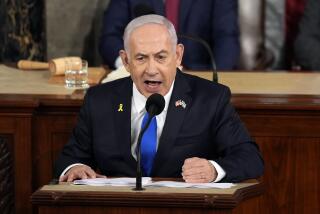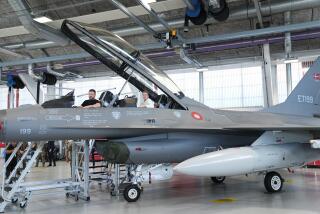Pentagon May Scrap Jet Plans
WASHINGTON — Facing severe budget pressures, the Pentagon is developing plans to slash the Air Force’s two prized fighter jet programs, according to Defense Department officials and outside experts.
Military planners are debating options to scale back the Air Force’s F-35 Joint Strike Fighter and the stealth F/A-22 fighter, as some defense officials question spending billions on weapons that have little use against terrorist networks and other unconventional threats.
Such a move would be an enormous blow to the Air Force, which has spent years developing the two weapons to replace its aging fleet of fighter jets. The budget cuts could encounter fierce resistance from lawmakers, including some from California, whose districts would be hit hard by the economic repercussions.
Yet as the Pentagon conducts a top-to-bottom assessment of its entire arsenal, defense officials are mindful that the military buildup that followed Sept. 11 is coming to an end. The war in Iraq, which now costs the Defense Department more than $4 billion per month, is contributing to the budget squeeze that jeopardizes some of the Pentagon’s most desired -- and expensive -- weapons.
The Joint Strike Fighter program is projected to cost $245 billion, a price tag shared by the Air Force, Navy, Marine Corps and nine U.S. allies, including Britain, Canada, Australia, Denmark and Turkey. It is the Pentagon’s most expensive weapons program, and the Air Force has by far the largest part of the budget; it hopes to purchase 1,763 of the planes to replace the F-16 fighter.
The Air Force also plans to acquire 179 F/A-22s, each costing about $345 million.
A Pentagon decision to scale back the programs would be the strongest signal yet of a significant change in strategic priorities. With Defense Secretary Donald H. Rumsfeld trying to transform the military to deal with unconventional threats, many say that weapons built for dogfights and eluding enemy radar are increasingly irrelevant.
“What does Al Qaeda’s air force look like?” said one defense official working on the Pentagon’s assessment, known as the Quadrennial Defense Review.
The Pentagon’s overall budget is expected to grow by 8% between now and the end of fiscal year 2011. Yet with the military planning to field about a dozen big-ticket planes, ships and submarines during that period, the Pentagon estimates that its budget for new weapons will balloon by 34%.
Some of these weapons, such as the Army’s Future Combat System -- a fleet of combat vehicles linked to a computer network -- and the Navy’s DDX destroyer, are being eyed for cutbacks to prevent a budget crisis later.
Because U.S. troops are heavily engaged in the Middle East and Central Asia, officials say there is little room to cut personnel costs from the Pentagon budget. Weapons, they say, are the only target for cost reductions.
Although Pentagon officials contend that no final decision has been made about the fate of the two Lockheed Martin-designed jets, some inside the Defense Department say that the deepest cuts could come in the Joint Strike Fighter program. According to one source, the Pentagon could cut the Air Force’s allotment of the planes by half.
Officials involved in the review process say that the option of canceling one or both of the programs is on the table, although it is extremely unlikely -- in part because such a move would cause a furor among members of Congress. The fact that close allies are involved in developing the JSF is another factor that should keep the program alive, the officials say.
Although Lockheed is the prime contractor for both jets, about 40% of the JSF is assembled at Northrop Grumman Corp.’s plant in Palmdale. Most of the F/A-22 is built at Lockheed’s plant in Marietta, Ga.
Pentagon spokesman Lawrence DiRita said it was too early in the review process to know what specific programs might be cut or expanded, and that planners were still identifying which types of missions the military ought to be preparing for.
“It’s definitely premature to say we’re looking at cuts,” said DiRita, who stressed that there were months remaining in the review -- due before Congress by early February -- and that no proposals had been presented to Rumsfeld.
He did say that Pentagon officials hoped to make some decisions about weapons programs by September or October, as the Defense Department prepared its fiscal year 2007 budget.
The Joint Strike Fighter and the F/A-22 have been plagued by cost overruns and production delays. In April, the Government Accountability Office called the JSF’s original business case, laid out by the Pentagon in 1996, “unexecutable.”
“When you have difficult budget choices to make, several of the Pentagon’s expensive modernization programs become likely targets,” said Andrew Krepinevich of the Center for Strategic and Budgetary Assessments in Washington.
“The JSF sits at the top of that list.”
Air Force officials are vigorously lobbying to preserve their coveted weapons, and supporters of the two programs point out that the emergence of China as a potential long-term threat is the best case for a large investment in fighter jet technology.
Last week, a Pentagon report warned that China’s military buildup threatened the balance of power in Asia, and that within a decade China’s military could pose a threat to modern militaries on the continent.
Air Force officials, who consider protecting the F/A-22 their top priority during the review process, argue that the jet’s stealth technology makes it essential for eluding the advanced radar systems the Chinese are developing.
The Pentagon has scaled back the number of F/A-22 jets it intends to buy from 381 aircraft to 179. But Pentagon officials say that deeper cuts in the number of planes purchased are possible.
Rumsfeld has repeatedly criticized the length of time it can take for a weapon to move from the drawing board to operational testing to deployment in the field.
“There’s no question that the longer it takes to field a program, the more expensive it becomes,” DiRita said.
The Pentagon has billed the 2005 Quadrennial Defense Review as a crucial step in the long-term effort to transform the military into a lighter, more agile fighting force.
As defense officials try to predict the types of threats U.S. forces will confront, they face hard choices about spending billions on weapons that in most cases were first envisioned during the Cold War.
Many defense experts point out that the success of Iraqi insurgents against U.S. troops is evidence that few enemies will choose to fight the U.S. military on the conventional battlefield.
Instead of buying expensive technology, they point out, the future of warfare requires that the Pentagon invest in counterinsurgency warfare and bulk up spending on armored vehicles, language training and civil affairs programs.
“The big cuts in fighters being considered are just one instance of a far broader rethinking in the Pentagon spending priorities,” said Loren Thompson of the Lexington Institute, a defense think tank in Arlington, Va. “Much of the impetus for these cuts originated in the Iraqi insurgency and in the need to wage a protracted war against terror.”
*
(BEGIN TEXT OF INFOBOX)
Vulnerable birds
A look at the two fighter jets that may have their budgets cut in a cost-cutting plan by the Defense Department; both jets are in production and not yet in use:
--
F-35 Joint Strike Fighter
Users: Air Force, Navy and Marines, and some foreign militaries
Schedule: Test flights are to begin in 2006.
Program cost: $245 billion
Contractors: Lockheed Martin Corp., main prime contractor. Northrop Grumman Corp. and BAE Systems, principal partners.
Manufacturing locations: Center fuselage by Northrop Grumman in Palmdale and El Segundo. Final assembly by Lockheed Martin in Fort Worth.
--
F/A-22 Raptor
Users: Air Force
Schedule: To be operational by the end of the year.
Program cost: $64 billion
Contractors: Boeing Co. and Lockheed Martin Corp.
Manufacturing locations: Wings and aft fuselage by Boeing in Seattle. Final assembly by Lockheed Martin in Marietta, Ga.
--
Sources: U.S. Air Force, Airforce-Technology.com, Boeing
Graphics reporting by John Jackson
More to Read
Sign up for Essential California
The most important California stories and recommendations in your inbox every morning.
You may occasionally receive promotional content from the Los Angeles Times.










